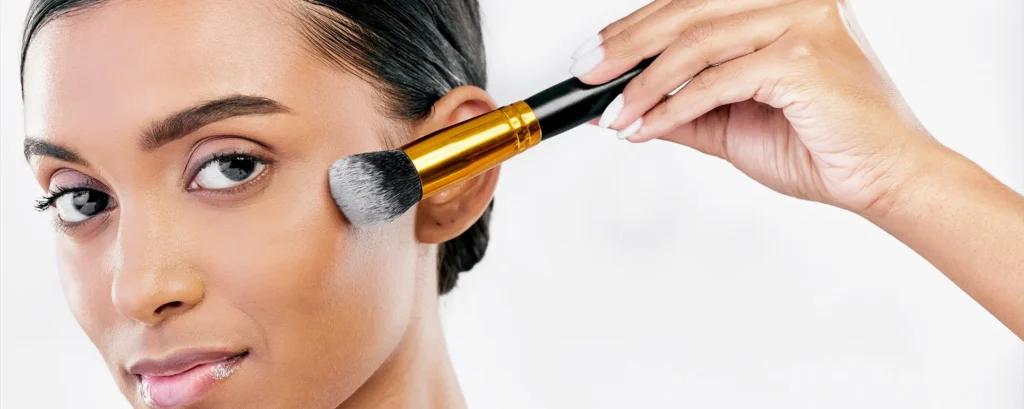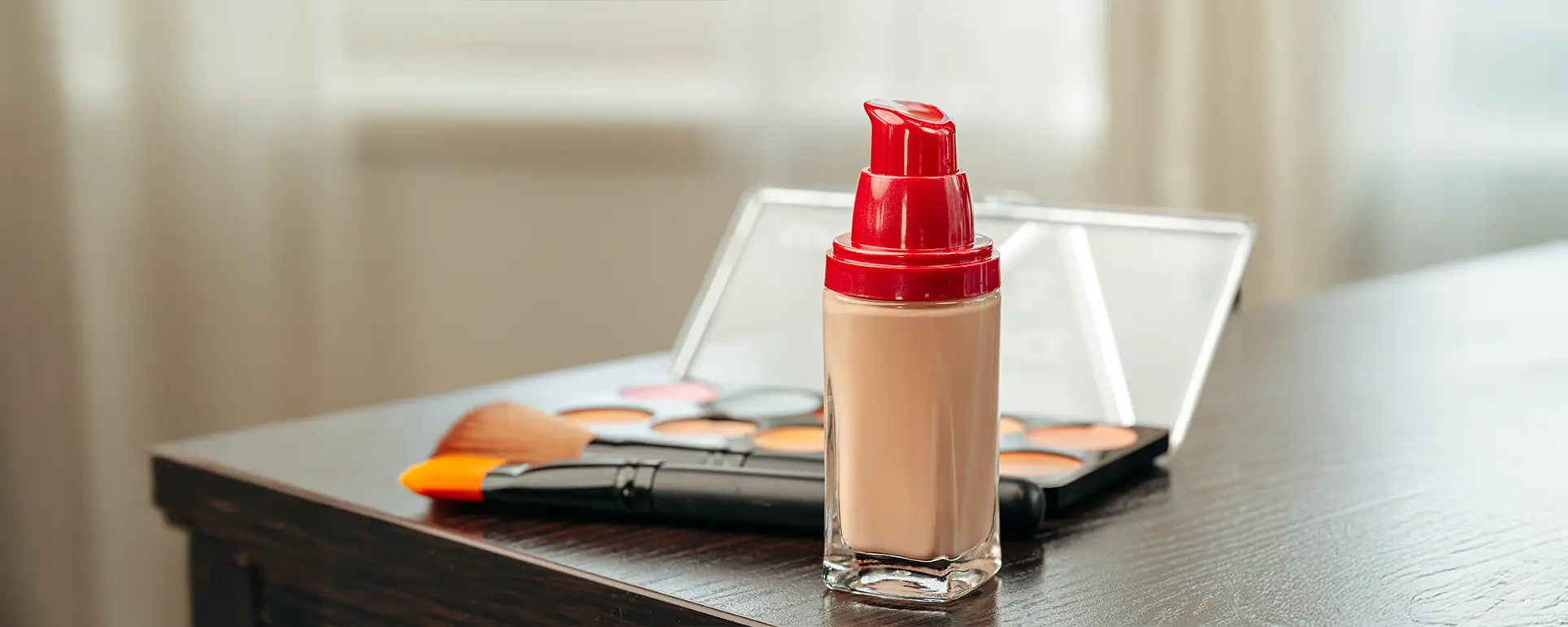Many people love the flawless, even finish that foundation provides, using it to conceal blemishes, redness, or uneven skin tone. A well-chosen foundation can boost confidence, create a polished appearance, and help your makeup look professional and long-lasting. However, for some, wearing foundation can lead to unexpected and frustrating skin issues, such as congested pores, excess oiliness, blackheads, whiteheads, and even acne breakouts.
It may seem confusing, especially because many foundations are labelled as non-comedogenic, meaning they are formulated to avoid blocking pores. Yet, even these products can sometimes contribute to skin congestion and irritation. Why does this happen? The answer lies in several factors, including the specific ingredients in the foundation, your unique skin type, how your skin reacts to certain formulations, and even your daily skincare and makeup application routine.
In addition, lifestyle factors such as not removing makeup thoroughly at the end of the day, using heavy moisturisers or sunscreens underneath foundation, or layering multiple products on the skin can all play a role in clogged pores. Even subtle issues, like applying foundation over slightly oily or dirty skin, can create a barrier that traps dirt, sebum, and dead skin cells in your pores, leading to congestion and breakouts over time.
Understanding why foundation clogs pores is essential if you want to enjoy a smooth, radiant makeup finish without compromising the health of your skin. By learning about the key triggers of pore congestion, how different ingredients interact with your skin, and the proper application and removal techniques, you can make informed choices. This knowledge allows you to wear foundation confidently, achieve a polished look, and maintain clear, balanced, and healthy skin at the same time.
How Foundation Can Affect Your Skin

Foundation is a key component of many makeup routines, designed to cover imperfections, even out skin tone, and create a smooth, polished appearance. While it can enhance your overall look, it can also affect the health of your skin, particularly your pores. Understanding how different ingredients, skin types, and application methods contribute to congestion is crucial for maintaining clear, healthy skin while still achieving a flawless finish.
1. Ingredients That Can Block Pores
Not all foundations are created equal, and the ingredients in your foundation can play a major role in whether your pores remain clear or become clogged. Some foundations contain heavy oils, silicones, waxes, or emollients that sit on the surface of the skin rather than being absorbed. While these ingredients can provide a smooth, long-lasting finish and a hydrated feel, they can also mix with sweat, sebum, dead skin cells, and environmental debris, forming a layer that blocks pores. Over time, this combination can lead to blackheads, whiteheads, or acne flare-ups. Even foundations labelled as “non-comedogenic” can sometimes contribute to congestion if the formula is too heavy for your specific skin type or if it interacts with other products in your routine.
2. Skin Type Matters
Your skin type strongly influences how foundation interacts with your pores:
- Oily Skin: Thick, creamy, or oil-rich foundations can trap excess sebum, worsening shine and increasing the likelihood of acne flare-ups. Oily skin tends to produce more natural oils, and when combined with a heavy foundation, this can create congestion in the pores. Lightweight, oil-free, or mattifying formulas are usually better suited for oily skin to provide coverage without exacerbating breakouts.
- Dry Skin: Powder or matte foundations may absorb too much of your natural oils, leading to flakiness, patchiness, or a cakey appearance. Dry skin benefits from hydrating or liquid foundations that contain moisturising ingredients, which help maintain skin balance while providing smooth coverage.
- Combination Skin: People with combination skin often experience oiliness in the T-zone and dryness on the cheeks or jawline. Using a one-size-fits-all foundation may lead to clogged pores in the oily areas or dryness in the rest of the face. Many dermatologists recommend using different formulations for different areas for example, a mattifying foundation for the T-zone and a hydrating or lightweight foundation for dry areas.
3. Application Techniques
Even the best foundation can cause problems if it’s applied incorrectly. Using too many layers can suffocate the skin and trap dirt, sebum, and dead skin cells in the pores. Unclean brushes, sponges, or fingers can introduce bacteria, further increasing the risk of breakouts. To reduce pore congestion, it’s important to:
- Use clean tools and wash brushes or sponges regularly.
- Apply foundation in thin, even layers rather than piling on multiple coats.
- Allow each layer to set slightly before applying the next, helping the skin breathe and preventing buildup.
- Avoid heavy layering over areas that are already prone to oiliness or breakouts.
4. Skincare Before and After Foundation
Your skincare routine plays a critical role in how foundation affects your pores. Applying foundation over a clean, well-moisturised face helps prevent it from mixing with excess oil or dead skin cells. Likewise, thoroughly removing makeup at the end of the day ensures that foundation and other products do not sit on the skin overnight, which can lead to clogged pores and breakouts. Using gentle cleansers, exfoliating regularly, and applying non-comedogenic moisturisers can all help minimise the risk of congestion while allowing your foundation to sit smoothly on the skin.
By considering ingredients, understanding your skin type, applying foundation correctly, and following a consistent skincare routine, you can enjoy the benefits of a flawless makeup finish without compromising the health of your pores.
Dermatologist-Recommended Tips for Healthy Foundation Application

Wearing foundation doesn’t have to come at the expense of your skin’s health. Many people worry that using makeup regularly can lead to clogged pores, breakouts, or irritation, but with the right approach, you can achieve a flawless complexion while maintaining healthy skin. Dermatologists emphasise that selecting the right products, preparing your skin properly, and following careful application and removal routines can significantly reduce these risks. Here are detailed, professional tips to help you wear foundation safely and effectively.
1. Choose the Right Formula
Selecting a foundation that complements your skin type is crucial for both appearance and skin health. Dermatologists recommend looking for non-comedogenic and oil-free formulas, as these are specifically formulated to minimise the risk of blocking pores. Non-comedogenic products are designed to avoid ingredients that can clog pores, which is especially important for individuals prone to acne or blackheads.
- For oily or combination skin, lightweight, breathable foundations are ideal. They provide coverage without feeling heavy or greasy, helping to control excess shine throughout the day.
- For dry skin, hydrating formulas with added moisturisers or humectants can prevent flakiness and help foundation blend smoothly.
- Checking the ingredient list is also essential. Avoid products with heavy oils, waxes, or certain silicones that may contribute to congestion. Ingredients such as mineral oil or lanolin, though common in some formulations, can be problematic for acne-prone skin.
Additionally, consider foundations with added skincare benefits, such as SPF, antioxidants, or hyaluronic acid, which can support your skin while providing coverage.
2. Prep Your Skin Properly
A clean, well-moisturised base is essential before applying foundation. Skipping this step can result in uneven coverage, patchiness, and even breakouts. Cleansing removes dirt, excess oil, makeup residue, and dead skin cells that could otherwise become trapped under makeup, leading to clogged pores and irritation.
After cleansing, it’s important to apply a suitable moisturiser. Hydrated skin helps foundation glide on smoothly and prevents dryness or flakiness, especially for dry or sensitive skin types. For added protection and longevity, consider using a lightweight primer, which creates a subtle barrier between your skin and the makeup. Primers can also help smooth fine lines, control oil, and improve the overall finish of your foundation.
Dermatologists also recommend allowing your moisturiser or primer to fully absorb before applying foundation, as layering products too quickly can lead to uneven texture or reduced effectiveness.
3. Apply Light Layers
When it comes to foundation application, less is often more. Applying thick layers can suffocate your skin, trap oils, and increase the risk of pore congestion or breakouts. Dermatologists advise building coverage gradually with thin layers.
Start with a small amount of foundation and blend carefully into the skin using clean fingers, a brush, or a sponge. Add more only where additional coverage is needed. This approach allows your skin to breathe, avoids a heavy or cakey appearance, and ensures a more natural and long-lasting finish.
Blending is also important. Use gentle, upward motions to distribute the product evenly across the face, paying attention to areas like the nose, forehead, and chin, where foundation tends to accumulate. Light layers also make it easier to touch up throughout the day without overloading the skin.
4. Clean Your Tools Regularly
Makeup brushes, sponges, and applicators are convenient tools for applying foundation, but they can become breeding grounds for bacteria, dead skin cells, and leftover product if not cleaned regularly. Using unclean tools repeatedly can introduce bacteria to your skin, increasing the risk of irritation, breakouts, or even infections.
Dermatologists recommend washing brushes and sponges at least once a week, or more frequently if you use them daily. Mild, antibacterial cleansers or gentle shampoo can effectively remove product buildup without damaging the bristles or sponge. Make sure tools are fully dried before use to prevent bacterial growth.
Over time, makeup tools also wear down and become less effective. Consider replacing old or fraying brushes and sponges to maintain optimal hygiene and application quality. Properly maintained tools not only protect your skin but also improve the smoothness and finish of your foundation.
5. Remove Makeup Thoroughly
Proper makeup removal at the end of the day is one of the most important steps in maintaining healthy skin. Even non-comedogenic foundations can cause congestion if left on overnight, leading to breakouts, irritation, or dull-looking skin.
Use a gentle cleanser suited to your skin type to remove all traces of makeup, dirt, and excess oil. For long-wearing, waterproof, or heavy foundations, dermatologists often recommend a double-cleansing routine. This involves using an oil-based cleanser first to dissolve makeup and sunscreen, followed by a water-based cleanser to remove residual impurities and ensure a truly clean canvas.
After cleansing, always follow up with a moisturiser to restore hydration and maintain your skin’s natural barrier. This step is essential for all skin types, including oily and acne-prone skin, as it helps regulate moisture and prevents the skin from overproducing oil.
6. Additional Dermatologist Tips
- Avoid sharing makeup products, as this can transfer bacteria and increase the risk of infection or breakouts.
- Pay attention to expiration dates; using old foundation can irritate the skin or cause infections.
- Consider incorporating weekly exfoliation to remove dead skin cells, but avoid over-exfoliating, which can compromise the skin barrier.
- Monitor your skin’s reaction to new products. If irritation or breakouts occur, discontinue use and consult a dermatologist.
By following these dermatologist-recommended steps, you can enjoy the benefits of wearing foundation flawless coverage, even skin tone, and confidence without compromising the health of your pores or overall skin. With proper product selection, careful application, and diligent skincare routines, foundation can become a tool that enhances your beauty safely and effectively.
When to Seek Expert Help
While many cases of clogged pores, occasional breakouts, or mild skin irritation can be effectively managed with proper skincare, careful foundation selection, and consistent makeup removal, there are situations where professional guidance becomes essential. If you notice persistent or worsening breakouts, ongoing redness, irritation, or discomfort despite following a diligent routine, it’s a clear signal that your skin may require expert attention. Ignoring these signs can lead to prolonged congestion, scarring, or more severe dermatological conditions over time.
Dermatologists and specialised skin or acne clinics are equipped to evaluate your skin thoroughly, looking beyond surface symptoms to identify underlying causes. Persistent pore congestion and breakouts may result from factors such as hormonal fluctuations, genetic predisposition, sensitivities or allergies to specific makeup ingredients, bacterial overgrowth, or pre-existing skin conditions like rosacea or eczema. Without a professional assessment, it can be difficult to pinpoint the exact trigger, and continuing to experiment with over-the-counter products may not resolve the issue and could potentially worsen it.
Visiting a professional, such as an Acne Clinic in London, offers several benefits. Experts can provide a personalised approach that includes recommending foundation types and formulas suited to your skin, advising on the most effective skincare routine, and offering treatments tailored to your needs. Advanced options may include prescription-strength topical medications, oral therapies, chemical exfoliants, or targeted laser treatments for severe or persistent acne. These interventions are far more effective than standard over-the-counter products, particularly for individuals struggling with recurring flare-ups or deeply inflamed areas.
Early professional intervention also plays a preventative role. By addressing congestion and breakouts promptly, dermatologists can help reduce the risk of long-term complications such as permanent scarring, hyperpigmentation, or uneven skin texture. Additionally, a professional can educate you on long-term skin health strategies, including selecting non-comedogenic makeup, applying foundation correctly, and maintaining a balanced skincare routine. This guidance empowers you to enjoy makeup without compromising the health of your skin.
Consulting a dermatologist or acne specialist is not just about treating existing issues it is an investment in your skin’s future. With professional support, you can confidently wear foundation and other makeup products knowing your pores are protected, your complexion remains clear, and your skin is receiving the appropriate care it needs. Regular check-ins with a dermatologist can also help you stay ahead of potential skin problems, making it easier to maintain healthy, radiant, and balanced skin year-round.
Ultimately, knowing when to seek expert help is a crucial step in maintaining both skin health and confidence. Persistent irritation or breakouts are signals from your skin that should never be ignored. Professional evaluation ensures you receive the right treatment, personalised advice, and the reassurance that your makeup routine supports, rather than hinders, your overall skin wellness.
Final Thought: Protect Your Skin While Wearing Foundation
Foundation shouldn’t have to come at the cost of healthy skin. By selecting the right formula, using proper techniques, and maintaining a good skincare routine, you can enjoy flawless coverage without clogged pores. You can get in touch with our Acne Clinic in London for personalised advice and treatments to keep your skin clear while enjoying makeup safely.
References:
- Yoon, E.J., 2024. Influence of cosmetic foundation cream on skin condition during aerobic exercise. Journal of Cosmetic Dermatology, [online] 23(2), pp. 1–7. Available at: https://pubmed.ncbi.nlm.nih.gov/38444348/
- Maarouf, M., Saberian, C. and Shi, V.Y., 2018. Myths, truths, and clinical relevance of comedogenicity product labeling. JAMA Dermatology, [online] 154(10), pp. 1131–1132. Available at: https://jamanetwork.com/journals/jamadermatology/fullarticle/2687007
- Katoulis, A.C., 1996. Comedogenicity of cosmetics: a review. Contact Dermatitis, [online] 35(6), pp. 361–365. Available at: https://www.sciencedirect.com/science/article/pii/0926995996000505
- Thiboutot, D., 2013. Acne vulgaris and the epidermal barrier. Journal of Clinical and Aesthetic Dermatology, [online] 6(10), pp. 19–24. Available at: https://pmc.ncbi.nlm.nih.gov/articles/PMC3579484/
Schachner, L.A., 2023. Insights into acne and the skin barrier: optimizing treatment regimens with ceramide-containing skincare. Journal of Clinical and Aesthetic Dermatology, [online] 16(7), pp. 14–22. Available at: https://onlinelibrary.wiley.com/doi/10.1111/jocd.15946
